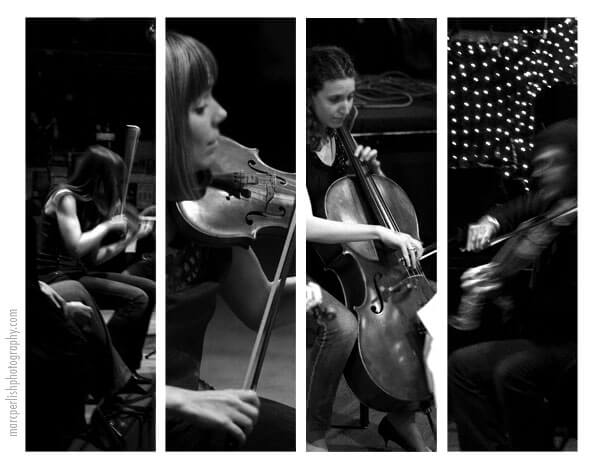

Chicago Q Ensemble at The Empty Bottle (photo credit: Marc Perlish Photography)
The program opened with Shawn Jaeger’s Thy Wondering Eyes (2010), a Midwest premiere. McSweeney introduced the piece, noting that it was partly inspired by Jaeger’s Kentucky roots, which were evident throughout the piece. Jumping off with a fractured bluegrass theme, the music careened from crazy rhythms and dissonance to dreamy sequences with long melodic lines; from an energetic, sometimes frenetic pace, to a slower, more deliberate tempo. Conjuring Kentucky’s hill country milieu, there were segments that evoked a back-woods revival meeting with call-and-response phrasing leading to a crazy-fast tempo, like a fast talking minister speaking in tongues. It was clear the players were deeply committed and thoroughly enjoyed playing this spirited work.
The middle section of the program was devoted to the older works of Shostakovich and Beethoven. It was a savvy move to excerpt and re-contextualize these scores, giving them a fresh, of-the-moment feel. The 1949 Shostakovich String Quartet No. 4, movements 3 and 4, proved to be an interesting pairing with Jaeger’s piece. The works are similarly grounded in a specific cultural setting, in this case the world of Eastern European Jews. The third movement was full of jovial conversation, a group of friends telling tall tales. Movement 4 was more weighty. Veering in and out of dissonance at the start, it transitioned through bucolic themes until a plaintive cry from McSweeney’s violin led into a lullaby-like conclusion carried by Sitzer’s cello. In the end, it was simply the deep-rooted humanity of the two pieces that tied the Jaeger and Shostakovich together. The opening movement of Beethoven’s String Quartet No. 12, Op. 127 started the second half of the concert. Isolated in this manner, it reminded us that, in his own era, Beethoven was as revolutionary and avant-garde as Jaeger and Greenstein may be in ours.

Kate Carter, Ellen McSweeney, Sara Sitzer, Dominic Johnson (photo credit: Marc Perlish Photography)
In case we hadn’t had enough power in our hour yet, the concert concluded with the Chicago premiere of Judd Greenstein’s Four on the Floor. It was a thrill ride in a hot rod convertible. In a surprise to everyone, Armbrust added a little high-test fuel to the Q’s tank when he unveiled a new (Un)familiar Music Series tradition of “doing shots” with the featured ensemble prior to their final number. In Johnson’s introduction to the piece, he suggested the audience not think too hard and just listen. That was good advice, as once the bows hit the strings, they set a furious nonstop pace. Johnson’s viola and Sitzer’s cello played the part of the high-rev engine. Carter and McSweeney’s violins played the hyped-up driver and passenger with the wind whipping through their hair. Despite the crazed pace, there was a discernible sequence of melodies and themes from the start. Suddenly, they downshifted into a more reflective section, as if they were fading as they disappeared into the distance. But they eventually came around the bend and brought the music down the home stretch to a rollicking finish. Because of the extremely fast tempo, it seemed that the musicians had little opportunity to make eye contact. It was a wonder they were able to keep in sync, especially considering that Johnson is a substitute violist. This performance of Four on the Floor was a clear testament to the expert capabilities of these players and, no doubt, a lot of grueling rehearsals. And it was one heck of a great preparation for those who were sticking around to indulge in the rock and roll.
Next up on the (Un)familiar Music Series will be Ensemble Dal Niente on May 22, featuring Jesse Langen (guitar) and Amanda DeBoer Bartlett (soprano) performing music of Aaron Einbond, Marcos Balter, Fred Gifford, Ray Evanoff, Chris Fisher-Lochhead, and Morgan Krauss.
–
Arlene and Larry Dunn are pure amateurs of contemporary music. Visit their blog at Acornometrics and follow them on Twitter: @ICEfansArleneLD.
